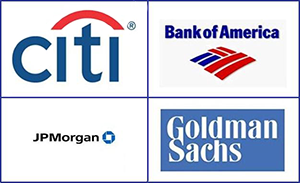Courtesy of Pam Martens
 As of March 31 of this year, there were 5,362 Federally-insured commercial banks and savings associations in the United States. Just two of these banks, JPMorgan Chase NA and Citibank NA control 75.7 percent of all precious metals derivatives contracts held by all of the 5,362 Federally-insured banks and savings associations. This finding comes from a report released last week by the regulator of national banks, the Office of the Comptroller of the Currency (OCC). (See Table 9 in the Appendix of the OCC report.)
As of March 31 of this year, there were 5,362 Federally-insured commercial banks and savings associations in the United States. Just two of these banks, JPMorgan Chase NA and Citibank NA control 75.7 percent of all precious metals derivatives contracts held by all of the 5,362 Federally-insured banks and savings associations. This finding comes from a report released last week by the regulator of national banks, the Office of the Comptroller of the Currency (OCC). (See Table 9 in the Appendix of the OCC report.)
Commercial banks are supposed to be making safe and sound business loans to keep the U.S. economy humming, creating good-paying jobs and making America competitive around the world. But according to the latest OCC report, of the $38.57 billion held in precious metals derivative contracts by all Federally-insured banks and savings associations in the U.S., JPMorgan Chase Bank NA held $17.509 billion and Citibank NA held $11.691 billion. JPMorgan Chase is currently under a criminal probe by the U.S. Department of Justice involving precious metals trades.
Equally concerning, the trading of precious metals derivative contracts by Federally-insured banks has grown exponentially since 2001. At that time it represented less than $5 billion. During the financial crisis in 2008 and 2009, precious metals derivative contracts at the banks were less than $15 billion. They have more than doubled since that time.
The weirdness doesn’t stop there. According to the latest OCC report, JPMorgan Chase Bank NA holds $2.4 trillion in stock (equity) derivative contracts – which represents 64 percent of all stock derivative contracts held by all 5,362 Federally-insured banks in the United States. If you include the stock derivative contracts held by Citibank, Goldman Sachs Bank USA (yes, the Great Vampire Squid is allowed by its regulators to own a Federally-insured bank) and Bank of America NA, together with the stock derivative contracts held by JPMorgan Chase Bank, you have 93 percent of all equity derivative contracts held by all 5,362 Federally-insured banks in the U.S. (See Table 10 in the Appendix of the latest OCC report.)
Why do these four banks need to trade high-risk stock derivatives in their taxpayer-backstopped, Federally-insured banks while the vast majority of other Federally-insured banks do not? There are two reasons. The first being that their lapdog regulators and a timid Congress are allowing them to do it. The second reason is that these are really high-risk Wall Street investment banks and brokerage firms in drag as staid, prudent, deposit-taking commercial banks. As a result of the repeal of the 66-year old Glass-Steagall Act in 1999 under the Wall Street-cozy administration of President Bill Clinton, these Wall Street trading behemoths are now allowed to own Federally-insured commercial banks and do pretty much anything they want with the Mom and Pop deposits held in those banks.
We do not say “pretty much anything they want” without solid evidence to back that up. Four years after the greatest Wall Street crash since the Great Depression, JPMorgan Chase was found to have used hundreds of billions of dollars of its depositors’ money to make wild gambles in exotic derivatives in London. It lost at least $6.2 billion of its depositors’ money on those gambles. The bank paid over $1 billion in fines to U.S. and U.K. regulators over the matter which became known as the “London Whale.” The OCC found that the trades “constituted recklessly unsafe and unsound practices,” and “was part of a pattern of misconduct.”
…



